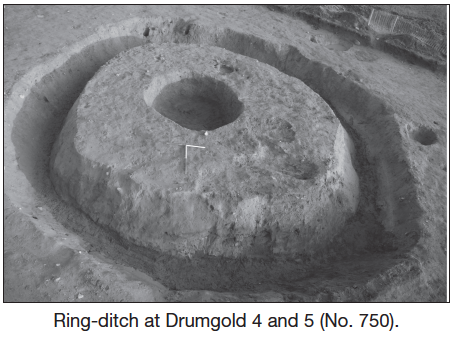2010:750 - DRUMGOLD (4 and 5), Wexford
County: Wexford
Site name: DRUMGOLD (4 and 5)
Sites and Monuments Record No.: N/A
Licence number: E004180
Author: Derek Gallagher, for TVAS (Ireland) Ltd.
Author/Organisation Address: Ahish, Ballinruan, Crusheen, Co. Clare
Site type: Ring-ditch, Cremation pit, Urn burial, Structure and Hearth
Period/Dating: Bronze Age (2200 BC-801 BC)
ITM: E 699948m, N 638666m
Latitude, Longitude (decimal degrees): 52.490246, -6.528240
Drumgold 4 and 5 were located on the proposed M11 Gorey to Enniscorthy scheme in a pasture field.
An oval ring-ditch contained three cremation burials and two inverted pots. The ring-ditch was 12.9m in diameter and within its centre were seven layers of stones and fifteen different deposits. The ditch itself was 1.26m deep with steep sides and a concave base and contained 21 fills. There were no cremation burials within the ditch fills and the only finds recovered were two pieces of flint from the upper deposits. Within the centre of the ring-ditch was an oval pit measuring 3.2m by 2.28m and 1.24m deep with steep sides and a flat base. Three cremation burials were placed at varying levels within the pit. One complete inverted ribbed bipartite bowl and one crushed inverted pot were also excavated from the centre of the ring-ditch. The inverted crushed pot was found in an earlier deposit below the intact pot and a flint plano-convex knife was also recovered at the same level. The base of the pit was fire-reddened and the initial layer of stones overlay this in situ burning, perhaps placed on top to quench the fire. This fire may have represented some form of ceremonial or ritual act to cleanse the pit before the deposition of burials within.
Other features recorded around the ring-ditch included four post-holes, eight pits, one hearth, one cremation burial-pit and twelve stake-holes.
The cremation burial-pit measured 0.5m by 0.49m and was 0.29m deep with gradual sides and a concave base. The primary fill consisted of a mid-brown sandy fill which included a perforated stone. Over this was a series of angular and sub-angular flat stones deliberately placed to form a cavity, within which was a loose black burnt sandy fill with frequent charcoal and burnt bones.
A large circular hearth measured 0.92m in diameter and 0.14m deep with gradual sides and a flat base. It contained a primary fill of a soft black silty clay with small stones and red burnt clay inclusions. Over this was a soft dark-yellow/brown silty clay. The centre of the hearth was truncated by a stake-hole. A second possible hearth measured 1.12m by 1.1m and was 0.15m deep with gradual sides and a flat base. It contained red/brown sandy clay with charcoal inclusions. The post-holes were 0.18–0.4m across and 0.15–0.66m deep, while the stake-holes had diameters of 0.05–0.11m and depths of 0.06–0.28m. Eight pits varied in shape and size and ranged from 0.42m x 0.32m x 0.08m to 2.37m x 1.28m x 0.47m.
The site represents Bronze Age funerary activity, as seen in the ring-ditch and associated cremation burials. Some domestic activity might be represented by the adjacent pits, post-holes and hearths.


